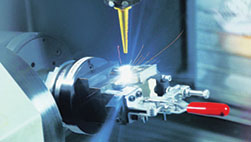by Charlotte Adams
 Operators have an array of choices when it comes to deciding what to do about worn or damaged parts. Among the options are buying a new part from an original equipment manufacturer (OEM), having the part repaired by an OEM-affiliated repair station, buying a new Parts Manufacturer Approval (PMA) component from a non-OEM source, and obtaining a designated engineering representative (DER)-approved repair. The choice depends on factors such as the age of the aircraft, the part’s warranty status, the cost of the various options, and the likely turnaround times for part delivery or repair approval. DER repair suppliers include MROs, PMA parts suppliers, and OEMs at various levels of the food chain.
Operators have an array of choices when it comes to deciding what to do about worn or damaged parts. Among the options are buying a new part from an original equipment manufacturer (OEM), having the part repaired by an OEM-affiliated repair station, buying a new Parts Manufacturer Approval (PMA) component from a non-OEM source, and obtaining a designated engineering representative (DER)-approved repair. The choice depends on factors such as the age of the aircraft, the part’s warranty status, the cost of the various options, and the likely turnaround times for part delivery or repair approval. DER repair suppliers include MROs, PMA parts suppliers, and OEMs at various levels of the food chain.
If a part can be repaired, the DER route may be the most cost-effective way to go, particularly if the airplane is out of warranty and the part is complex, costly, and difficult to obtain in a timely manner. A DER repair is a repair process and configuration that has met all the specifications for development, performance, reliability, and safety, and has been validated and certified by an FAA-authorized DER, explains John McKirdy, vice president, commercial aerospace global accounts, for Chromalloy, a supplier of new parts and DER repairs for aircraft engine components. Within the ranks of DERs the repair specification-DERs (RS-DERs) provide additional flexibility, as they can both evaluate how to do a repair and approve the repair.
The FAA has approved only a small number of independent RS-DERs (between 32 and 70), says Dominick DaCosta, chief operating officer of the Delegated Engineering Service Group, an independent DER consultant firm. The number depends on how they are counted. For example, one DER can havemore than one RS-DER delegation disciplines such as, Chart A [Structures], Chart B [Powerplant], Chart C1 [Mech Systems], and Chart E, [Engines], making the count appear somewhat higher if those individuals are counted more than once. These private individuals designated by the FAA are in essence review agents for the agency, he says. The very restricted number of RS-DERs is unfortunate because these designees “are really more needed than anything else we’ve got because so many field approvals could be subject to RS-DER work,” says Jason Dickstein, president of the Washington Aviation Group law firm.
RS-DERs focus on major repairs, as minor repairs of very limited scope can be performed by a repair station in coordination with its local FAA Flight Standards office. But the RS-DER has to run any major repair to an engine, wing, or landing gear through the FAA, says Sarah MacLeod, executive director of the Aeronautical Repair Station Association (ARSA). This is explained in the FAA’s “DER Handbook,” Order 8110.37E, DaCosta says. Normally, the RS-DER must coordinate with the Flight Standards District Office (FSDO) that oversees the applicant, DaCosta says, referring to Section 4-13 (e) of this Order. So even if a project falls within the RS-DER’s authority, the FSDO who oversees the applicant repair facility must be aware of and be able to monitor that applicant’s new activities.